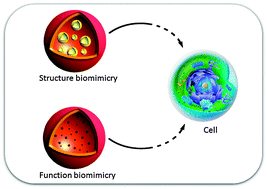The cell is certainly one of the most complex and exciting systems in Nature that scientists are still trying to fully understand. Such a challenge pushes material scientists to seek to reproduce its perfection by building biomimetic materials with high-added value and previously unmatched properties. Thanks to their versatility, their robustness and the current state of polymer chemistry science, we believe polymer-based materials to constitute or represent ideal candidates when addressing the challenge of biomimicry, which defines the focus of this review. The first step consists in mimicking the structure of the cell: its inner compartments, the organelles, with a multicompartmentalized structure, and the rest, i.e. the cytoplasm minus the organelles (mainly cytoskeleton/cytosol) with gels or particular solutions (highly concentrated for example) in one compartment, and finally the combination of both. Achieving this first structural step enables us to considerably widen the gap of possibilities in drug delivery systems. Another powerful property of the cell lies in its metabolic function. The second step is therefore to achieve enzymatic reactions in a compartment, as occurs in the organelles, in a highly controlled, selective and efficient manner. We classify the most exciting polymersome nanoreactors reported in our opinion into two different subsections, depending on their very final concept or purpose of design. We also highlight in a thorough table the experimental sections crucial to such work. Finally, after achieving control over these prerequisites, scientists are able to combine them and push the frontiers of biomimicry further: from cell structure mimics towards a controlled biofunctionality. Such a biomimetic approach in material design and the future research it will stimulate, are believed to bring considerable enrichments to the fields of drug delivery, (bio)sensors, (bio)catalysis and (bio)technology.


 Please wait while we load your content...
Please wait while we load your content...